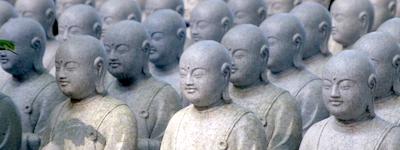As a slow learner of Japanese, I often have to look up kanji (Chinese characters) in my dictionary. I was intrigued to notice that for some kanji, one of their meanings is a very large number:
| Kanji | Reading | Number |
|---|---|---|
| 万 | man | 104 |
| 億 | oku | 108 |
| 兆 | chō | 1012 |
| 京 | kei | 1016 |
| 垓 | gai | 1020 |
| 𥝱 | jo | 1024 |
| 穣 | jō | 1028 |
| 溝 | kō | 1032 |
| 澗 | kan | 1036 |
| 正 | sei | 1040 |
| 載 | sai | 1044 |
| 極 | goku | 1048 |
Table 1. Kanji for large numbers with readings and number values
Kanji and the supercomputer
For example, the character 京, which is the “kyō” in Kyoto (京都) means “metropolis”, but also 1016. For that meaning it is pronounced “kei”, and this is the origin of the name of the famous Riken supercomputer in Kobe, the “K computer”: it is a computer capable of 10 petaflops, so 1016 or kei flops. Incidentally, it is probably the only supercomputer that has its own railway station, 京コンピュータ前駅.

Counting systems
The story of how these kanji came to represent such large numbers is quite interesting. It started with the emergence of a number of different counting systems.
Japan has adopted kanji from China – the word kanji (漢字) means Chinese characters, the 漢 character meaning “Han”. The traditional numeral systems of China, Korea, and Japan are all decimal-based but grouped into ten thousands, also known as myriads (man, 万), rather than thousands. Very long ago, the characters beyond man simply indicated degrees of large, so oku (億) was larger than man (万), chō (兆) was larger than oku, kei (京) was larger than chō, etc. Actual counting of numbers beyond one myriad was ten myriads, hundred myriads, thousand myriads.
Then over time the characters oku, chō, kei etc. started to be used for this, in a counting system called kasū (下数,かすう, “lower arithmetic”). So in this system, oku was ten times man, chō was ten times oku, etc. This was very long ago, more than two thousand years, and clearly it was not entirely satisfactory because already from the Han dynasty onwards (i.e. 200 BCE), a separate counting system called jōsū(上数,じょうすう,”upper arithmetic”)also became used. In this system, the character after man got the value of man man (万万), so oku = man man = 108. The next value chō became oku oku (億億) = 1016, kei = chō chō (兆兆) =1032 and so on. Later, yet another system, called chūsū (中数,ちゅうすう,”middle arithmetic”) came into use. In this system, the values for consecutive kanji where 104 apart. To be precise, in China there were two variants of chūsū, manshin (万進) and (万万進) manmanshin, the latter had intervals of 108.
The table below summarises the various systems:
| Kanji | Reading | kasū (下数) | chūsū/manshin (中数/万進) | chūsū/manmanshin (中数/万万進) | jōsū (上数) |
|---|---|---|---|---|---|
| 万 | man | 104 | 104 | 104 | 104 |
| 億 | oku | 105 | 104×2=108 | 108×1=108 | 104×2=108 |
| 兆 | chō | 106 | 104×3=1012 | 108×2=1016 | 104×22=1016 |
| 京 | kei | 107 | 104×4=1016 | 108×3=1024 | 104×23=1032 |
| 垓 | gai | 108 | 104×5=1020 | 108×4=1032 | 104×24=1064 |
| 秭 | jo | 109 | 104×6=1024 | 108×5=1040 | 104×25=10128 |
| 穣 | jō | 1010 | 104×7=1028 | 108×6=1048 | 104×26=10256 |
| 溝 | kō | 1011 | 104×8=1032 | 108×7=1056 | 104×27=10512 |
| 澗 | kan | 1012 | 104×9=1036 | 108×8=1064 | 104×28=101024 |
| 正 | sei | 1013 | 104×10=1040 | 108×9=1072 | 104×29=102048 |
| 載 | sai | 1014 | 104×11=1044 | 108×10=1080 | 104×210=104096 |
| 極 | goku | 1015 | 104×12= 1048 | 108×11=1088 | 104×211=108192 |
Table 2. Summary of the different counting systems used historically
An Edo-era mathematics book
In Edo-era Japan, the 1634 edition of an influential mathematics book, jinkōki (塵劫記), standardised on the chūsū/manshin (中数/万進) system as shown in the table above. The work covers a wide variety of mathematical problems but its main purpose was to explain techniques for calculating using the soroban (算盤), the Japanese abacus.
The daimyo, the samurai and the soroban
The oldest soroban in existence is the Shibei Shigekatsu hairyo soroban, from 1591. It was made from plum tree wood and silver and given to the samurai Shibei Shigekatsu by the famous daimyō Toyotomi Hideyoshi (The word hairyo (拝領) means “receiving from a superior”). It shows that this kind of calculating device was highly valued. This soroban has 20 number rods, so it can represent any number up to 1020-1. So in any case the introduction of the soroban made it easier to conceive very large numbers.
Buddhist angels and mustard seeds
The story so far does not quite explain where those different systems came from or why these choices were made, and indeed earlier editions of the jinkōki used different combinations of kasū and chūsū. In any case, it turns out that the origin of these very large numbers lies in ancient Buddhist texts.
Buddhism has the notion of a kalpa or aeon, a very long unit of time. There are in the old texts two definitions for a kalpa, provided by the Buddha by analogy. I found the following explanation on a Japanese web site for the book “巨大数入門” (“An introduction to very large numbers”):
『仏教では、とても長い時間を表すときに劫(こう)という時間の単位が使われます。「未来永劫」「億劫」「五劫のすり切れ」などの言葉は、ここから来ています。この「劫」には2通りの意味があり、1つ目は「磐石劫」で、四十里四方の大石を、いわゆる天人の羽衣で百年に一度払い、その大きな石が摩滅して無くなってもなお「一劫」の時間は終わらないと譬えています。 2つ目は「芥子劫」で、方四十里の城に小さな芥子粒を満たして百年に一度、一粒ずつ取り去り、その芥子がすべて無くなってもなお尽きないほどの長い時間が一劫であるとのことです。』
Loosely translated, this means that there are two definitions for a kalpa:
- Imagine a huge cube of rock of 40 ri on the side. Every hundred years, an angel brushes the rock with its wings. A kalpa won’t have ended by the time it takes to entirely wear away the rock.
- Imagine a huge building of 40 ri on the side. Every hundred years, a small mustard seed is put into it. The kalpa won’t have ended by the time the building is full.
To estimate how long a kalpa actually lasts, someone made the following assumptions:
- Suppose the angel’s wings remove one layer of atoms over an area of one square meter. Given that 1 ri is 500 m and the diameter of an atom is 0.2 nm, it would take 4×1024 years to wear away the rock.
- For the second definition, assuming a mustard seed is 0.5 mm, it would take 6.4×1024 years to fill the entire volume.
It’s rather striking that both estimates produce the same order of magnitude, 1024 years. For comparison, the estimated age of the universe is “only” 1.38×1010 years.
Grains of sand in the Ganges
Regardless, it means that Buddhist scholar monks had a need to express very large numbers. In fact, Buddhism has concepts such as the number of grains of sand in the Ganges (gōgasha,恒河沙), which are even larger than goku (極, 1048). The largest quantified term I could find in my dictionary is muryōtaisū (無量大数,”immeasurably large number”), with a value of 1068 using chūsū, but often defined as 1088, due to a variant system used for values above goku used in the 1631 edition of the jinkōki.
